Black and White Photography Black and White Easy Drawings
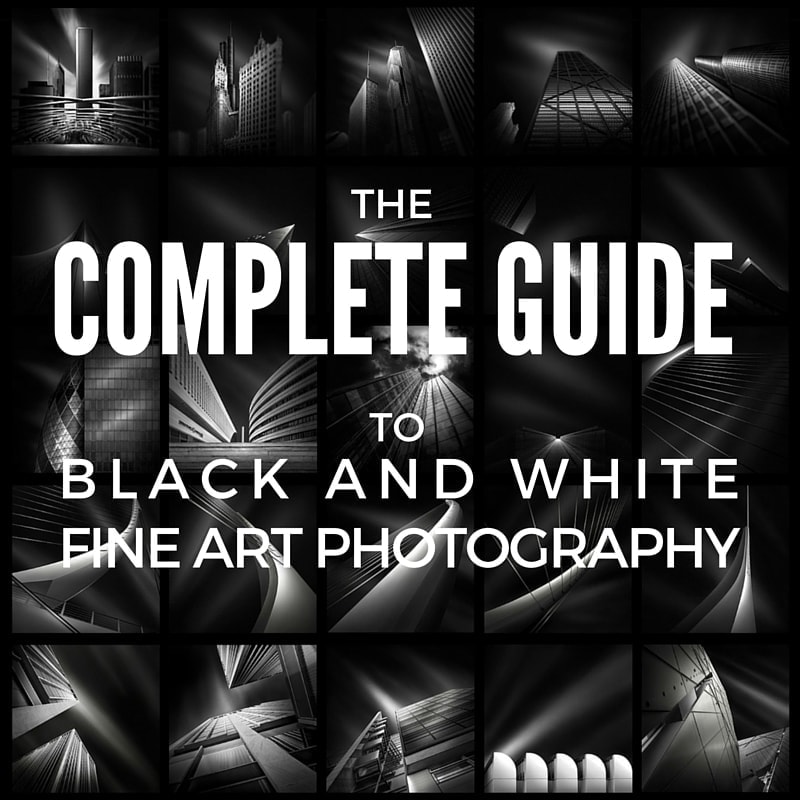
COMPLETE GUIDE TO BLACK AND WHITE FINE ART PHOTOGRAPHY
UPDATED 2022
The aim of this guide to black and white fine art photography is to give you the tools to create compelling award-winning black and white photography
This guide to black and white fine art photography is a compilation of the most important principles of black and white photography, or the most important guidelines for creating monochrome photography, that I created for my photography students and I now gathered into a complete guide to share it with you.
These principles are easy to understand and they will take your black and white fine art photography to a new level, whether you work with black and white architecture, black and white landscapes, black and white portraits, or still life. They belong to the general principles for creating good black and white photographs and do not depend on the subject matter you work with. They will give your black and white photography the extra element that will make it unforgettable for the viewer.
I will be updating this guide to black and white fine art photography as I discover more and better ways of creating black and white fine art photography, so if you will consult it in the future you may find even more guidelines or ways to produce good black and white photography. We are all constantly learning, so do I, and this makes us better artists and helps us be as close as possible to perfection, which is one of the characteristics of fine art photography.
If you'd like to be automatically updated on the changes on this article as well as on my latest tutorials and articles you can subscribe to my website and you will be the first to know when there is new content on this website.
1/ INTRODUCTION TO THE GUIDE TO BLACK AND WHITE FINE ART PHOTOGRAPHY
Creating black and white photography is different from creating color photography and one needs to be aware of the differences in order to be able to create good black and white photography. This stands especially for black and white fine art photography, where the input of the artist is much more important than the subject he is working with, or the reality he is capturing and, by extension, the image the camera captures, which is only the starting point in the creation of the final black and white photograph. This is one of the main ideas we are going to focus on in this guide to black and white fine art photography.
Study Resources – Books and Video Tutorial
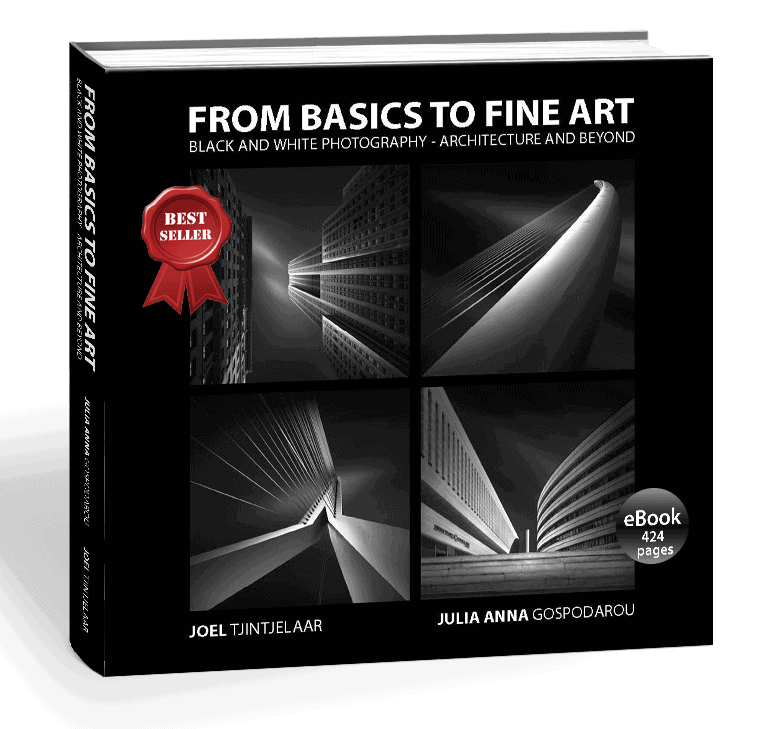
Considered "the best book on black and white photography written in the last 40 years" (George DeWolfe), my book From Basics to Fine Art – Black and White Photography is one of the best resources to study black and white fine art photography. If you own the book, a good starting point is to read Chapter 11: "How to see in black and white" written by myself and Chapter 12: "Rule of Grays" by my co-author Joel Tjintjelaar. In the book, we go beyond a simple guide to black and white fine art photography and we explain in-depth, in hundreds of pages, which are the principles of black and white photography and what you need to have in mind when creating your own photographs. The aim is to produce compelling black and white images that are not only a recording of the scene in front of us, but can also produce emotion in the viewer's heart. In black and white fine art photography, creation is not only about producing good and correctly executed and processed photographs, it is also about producing photography with EMOTION, in other words, producing fine art photography.
For a more in-depth analysis of black and white post-processing and of how to see the shapes and volumes you photograph, how to interpret and render them, also as an addition to the chapters above you can read Chapter 10: "Photography Drawing" that you can partly read also on my website, where I describe my black and white processing method and this will make you understand my why I process my images the way I do and what I practically do to make them look like this.
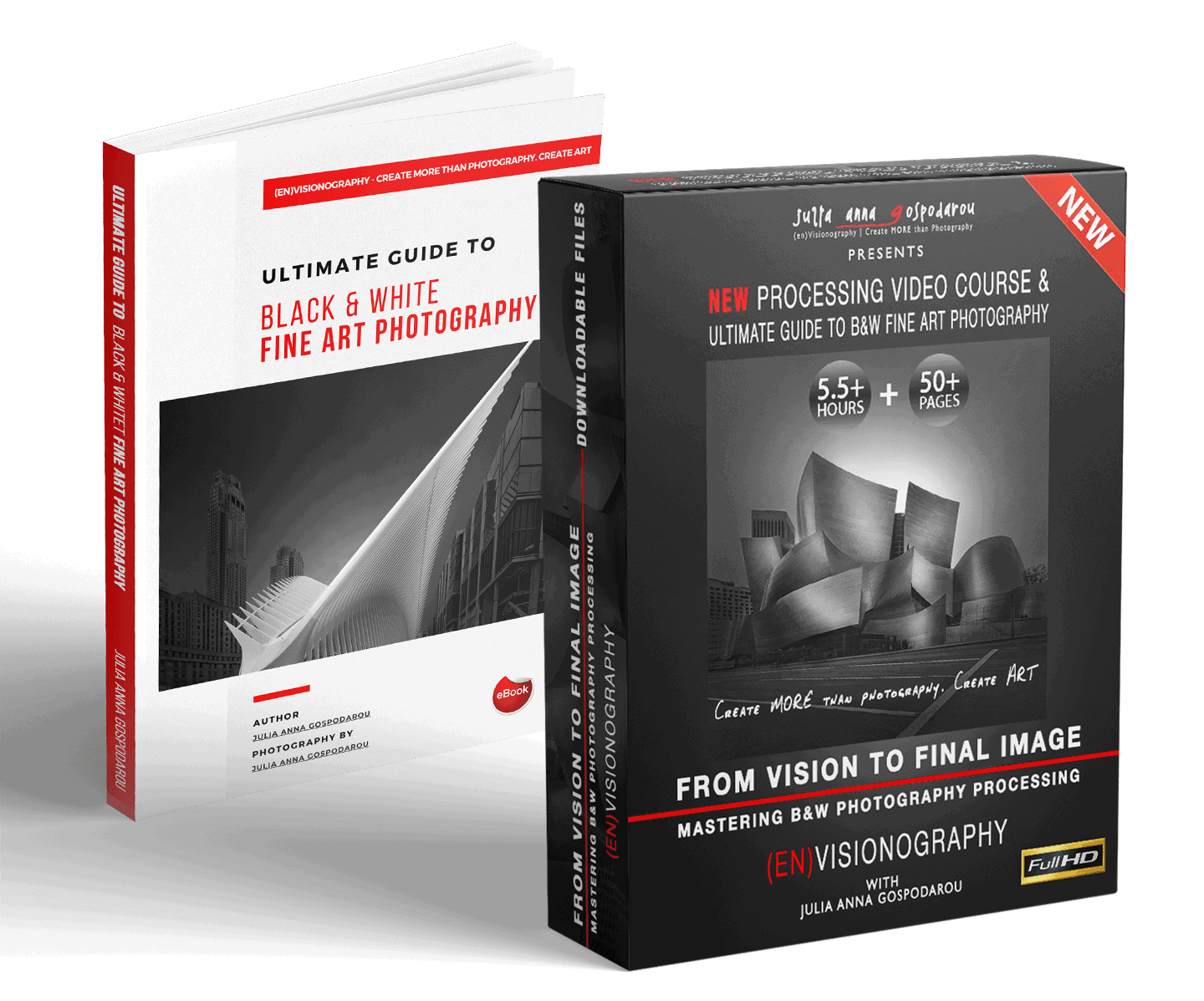
The second good resource for studying fine art black and white photography is my video course Mastering Black and White Photography Processing – From Vision to Final Image that comes together with the eBook "Ultimate Guide to Black and White Fine Art Photography", a course that analyses in-depth my personal processing method for creating three-dimensionality in photography that I call Photography Drawing.

A third good resource for studying fine art black and white photography is my video tutorial Long Exposure, Architecture, Fine Art Photography – Creating (en)Visionography that is accompanied by the eBook "Advanced Black and White Processing with Photography Drawing" where I present the highlights of my black and white processing workflow with my signature method Photography Drawing. The video tutorial drives you through the process of creating fine art photography, and (en)Visionography, and analyzes the ways you can express yourselves artistically from a practical point of view.
In addition to what you can study in the video tutorial and the two books, I will tell you a few more things about what to focus on when working in black and white and especially black and white fine art photography.
Since we are speaking about long exposure and since this is one of the techniques I use extensively in my photography, if you want to learn more about it, besides watching the video tutorial, you can also read my Long Exposure Photography Extensive Tutorial that is a complete guide to this fascinating technique.
2/ VISION IN BLACK AND WHITE FINE ART PHOTOGRAPHY

VISION – THIS IS WHERE IT ALL BEGINS
In fine art photography, everything starts in your mind. It doesn't start in the outside world, but inside yourself, in your mind and soul. Therefore, you need to have a "black and white mind" and a "black and white soul", in the figurative sense of the word, of course – so you can express your vision in black and white.
Of course, you need vision to create any kind of fine art photography, but creating black and white photography means expressing your vision with the specific tools that make a black and white image possible, which develop around light and the shades of gray.
What does this mean?
This means many things, among which the ability to go deeper in your creative work and access the essence of things, in order to recognize what is important in what you photograph and what needs to be emphasized. You do that because you need to discover your subject, to recognize it, to recognize your internal idea in the external world. This is how you will know which scene, subject, point of view, light conditions will be the best raw material you can use to recreate your vision in a black and white photograph.
In black and white photography, you need to " see in black and white" This doesn't mean only seeing how the color scene in front of you will look in black and white, in terms of gray tones equivalents it in term of contrast, as it has been many times suggested as a way of seeing and creating black and white photography. "Seeing in black and white" means being able to see how the scene in front of you will recreate your vision. It means deciding what to choose and capture out of that specific scene. It means being able to create the best basis for your processing work when capturing a subject, so the idea in your mind, your story, can be faithfully and clearly conveyed to the viewer.
If you want to find out more about what I mean when I talk about vision being the primordial element when creating black and white photography, except for consulting this guide to black and white fine art photography, you can also read Chapter 6 – "The Guide to Vision" in my book From Basics to Fine Art – Black and White Photography, that I mentioned previously, You can also consult a more concise version of this guide on my website.
The Guide to Vision was created based on my long experience as a photographer, architect, and visual artist, and on studying the best examples of expressing your vision in art and photography.
3/ EMOTION AS THE FIRST ARTISTIC TOOL IN BLACK AND WHITE FINE ART
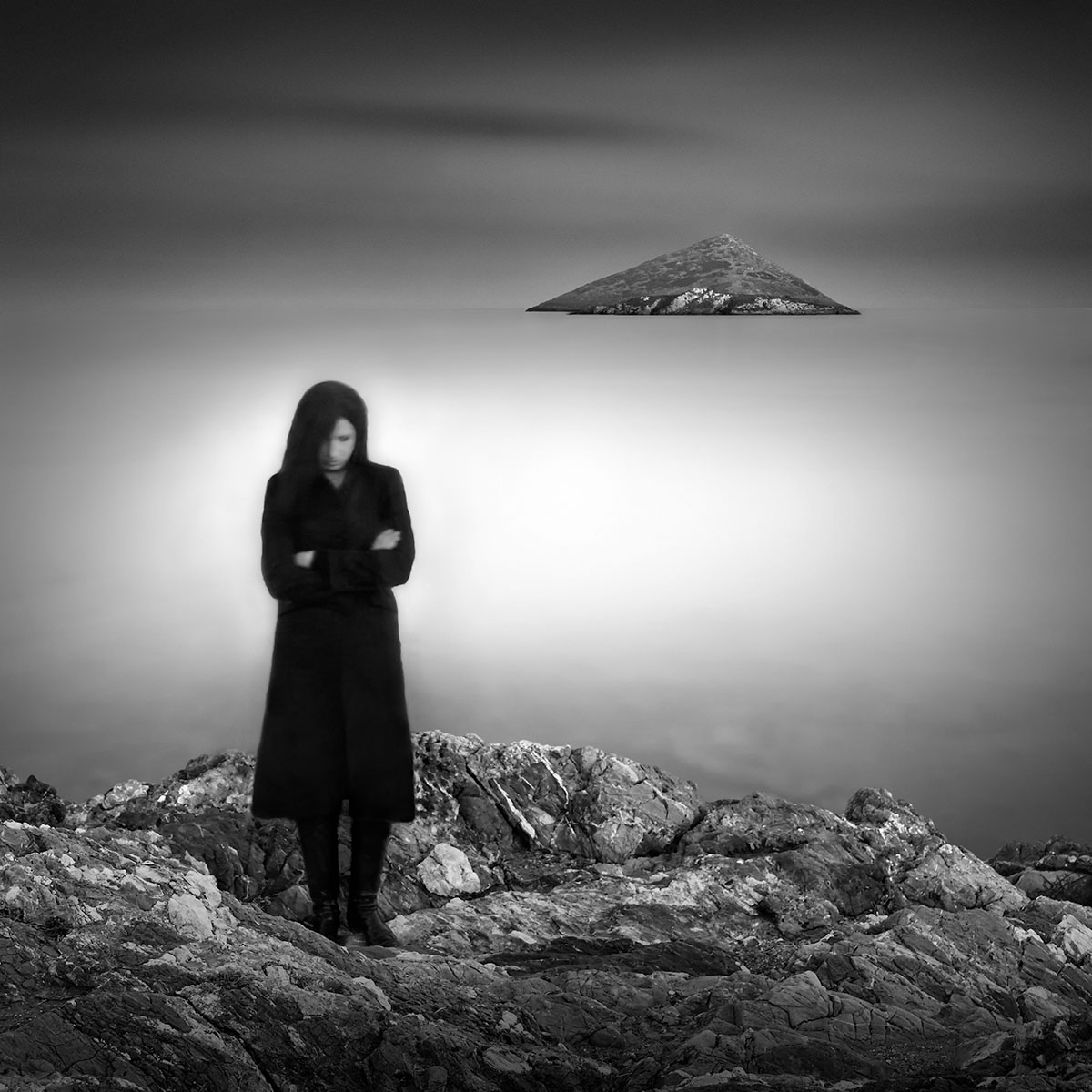
When working in black and white you have to be curious and aim to unveil the hidden side of the world, the side that exists beyond color and beyond objective reality. You need to be bold enough to work with a very fragile material: your emotions and the emotions of the viewer.
Black and white fine art photography is not about rigid rules and stiff techniques, it is not about gear or perfect conditions. Black and white fine art photography is about provoking emotion, about making the viewer's soul vibrate at the view of the masterfully handled gray tones in your image, it is about recreating the world by using symbols and these symbols are the 256 shades of gray in your black and white photographs.
By reducing a color image that has millions of hues of color to a black and white image with only 256 shades of gray, you aim to reduce the world to its essence, to its primordial force. That force overpowers everything and makes the world go around. That force is EMOTION , as the material manifestation of LOVE .
4/ LIGHT IN BLACK AND WHITE PHOTOGRAPHY

"Let there be light…"
I'm sure everyone knows this quote from the Bible. For me, this quote says it in the clearest way, regardless of what each one of us believes spiritually, how important light is.
First, there was light, and then anything else.
First, there was light, and then photography.
What we essentially do in black and white photography is to work with light and shadow. My Photography Drawing processing method (PhtD) is based on how to use light and shadow to render a scene, how to "draw a photograph" in order to create the image we envisioned and induce emotion in the viewer. If you are not familiar with this method, you can find more details in my book From Basics to Fine Art ad on my website.
Keep in mind that the first thing we are interested in, in black and white photography, is light. Not color, contrast or anything else. l
Light is the first thing our eyes are drawn to, from the moment we are born.
it is the stimulus to which our senses react most naturally and spontaneously.
when we know this fact we can use it in our photography to improve the way we communicate.
What we are interested in when creating black and white photography, is the light and all its gradations, the light that we capture and then emphasize or even recreate in our images through post-processing. Light is what reveals the world to us, it is the very prerequisite of seeing and it is what makes photography possible. Light is everywhere and this is why most of the time we don't even think about it. We only notice it when it is different than usual, more beautiful or special, more extreme, or more dramatic than normal. But when working in black and white we should always be careful and observe the light we have in front of us, regardless if it is a special light or plain common light. We have to observe it, read it, interpret it, and then strive to use its full potential to create the image.
Light is the pencil that will draw on paper the photograph we create in our mind, both the light we see in front of us and the light we create through post-processing.
5/ LIGHT AND SHADOW, AND THEIR IMPORTANCE WHEN WORKING IN BLACK AND WHITE

The opposite of light is shadow
Shadow cannot exist without light, it is its counterpart, its completion and opposite. Light and shadow are like yin and yang and they should always be seen, analyzed, and interpreted together, both when capturing a black and white photograph, as well as when post-processing a black and white photograph. They are both very powerful tools in our hands as photographers and as (en)Visionographers, that not only capture this light and shadow, but also re-interpret it so to be able to give birth to something more than just photography, to (en)Visionography and the manifestation of our vision through the image we create.
Light and shadow are our most powerful allies in creating black and white fine art photography because they are the basis of photography in general, they are what allows us to see in the first place, they are the first thing we see in our life so we are the most sensitive to them and able to react to the emotion they can create.
By using light and shadow wisely we can recreate any emotion, in any intensity.
6/ THE GRADATIONS OF LIGHT

This topic couldn't be missing from this guide to black and white fine art photography, since light is paramount in black and white photography.
When taking photographs with the intention to work on them in black and white, try to look at the world around you in a different way and start with observing the variations of light on a surface, the way it transforms from light to shadow, from bright to dark, by transiting all the shades of gray in-between. Observe all the gradations it creates and how smooth or harsh this transition is, depending on the intensity of the light falling on that surface. The gradations in the gray tones will be steeper in the case the light is harsher, creating higher contrast, and smoother in the case the light is softer, creating lower contrast.
The gradations of light are what will create depth in the image and make it look three-dimensional.
The gradations of light already exist around us in the scene we photograph, but it is even more important to create them when processing the image, because they are what will make our image believable and allow the viewer to see a three-dimensional world in the photograph.
7/ CREATING CONTRAST IN BLACK AND WHITE PHOTOGRAPHY

Try to place a black surface next to a white surface and you will see how powerful the contrast between them will be. It will attract the eye immediately and will make you look instantly at the area where the two surfaces meet. It will magnetize your eyes and hold you "captive", looking at how these extremes of light interact with each other, until the moment you can find enough power to move your eyes from the point where they meet. And even if you manage to free your eyes from this "captivity", you will still feel dizzy before you adapt to normal tones and intensities.
Now think about it, and tell me if this is not one of the most powerful tools you can use to attract the viewer into your photograph so you can keep them there as long as you need to tell them your story. It almost seems like a trick, like a manipulation; this is how powerful contrast can be in a black and white photograph. Because of its power, just like any other powerful tool, it should be used with measure and smartly. We don't want to overwhelm the viewer, to shock them, we want to seduce them and invite them to find out more about our image.
If you replace the white with bright tones, and the back with dark tones, you will soften the effect, making it less aggressive, but you will still keep intact the power the contrast has.
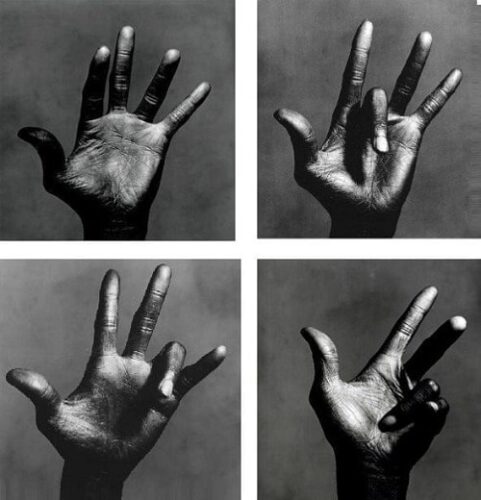
Using contrast wisely, placing it in the right amount in the right places is something all famous black and white photographers have understood and used in their work and this is one of the reasons their work is so striking.
There are many photographers whose work I could bring as an example of how to use contrast, but I can't help but think of Miles' Davis black and white portraits and hands still life photos by Irving Penn when I think of a genius use of contrast. You have to see these photographs in large to fully understand their power, but you can get an idea from the images I'm showing here too.
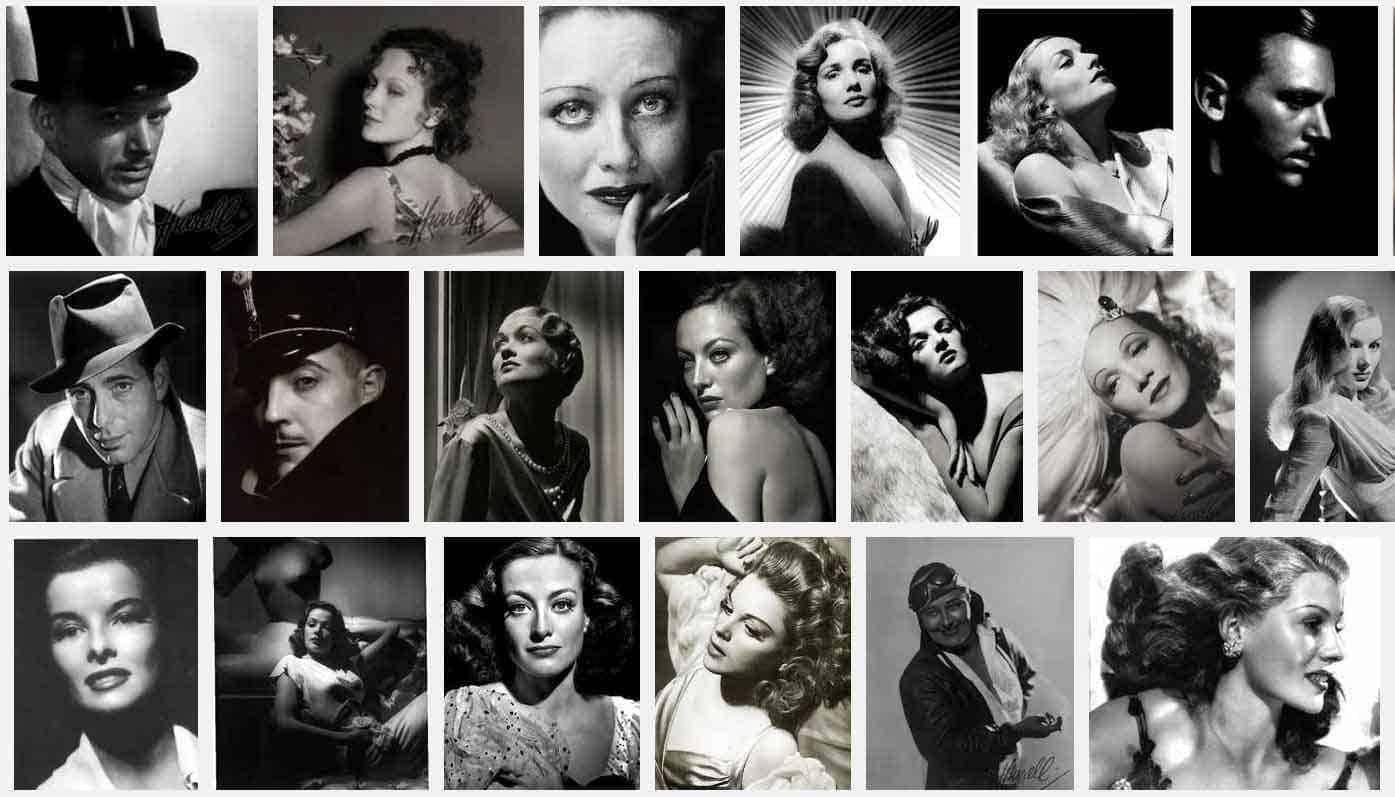
Another good example of great use of contrast to create powerful and atmospheric images is the Hollywood glamour portrait work of George Hurrell . Have a look at his work in the link and you will understand why you like so much the old black and white movies where you can see this type of contrast too.
These are just a few examples of great use of contrast but if you search further you will find many other examples in the work of remarkable photographers that will leave you fascinated by the intense emotion that contrast can create in a black and white photograph.
8/ COVERING THE ENTIRE TONAL RANGE BETWEEN BLACK AND WHITE
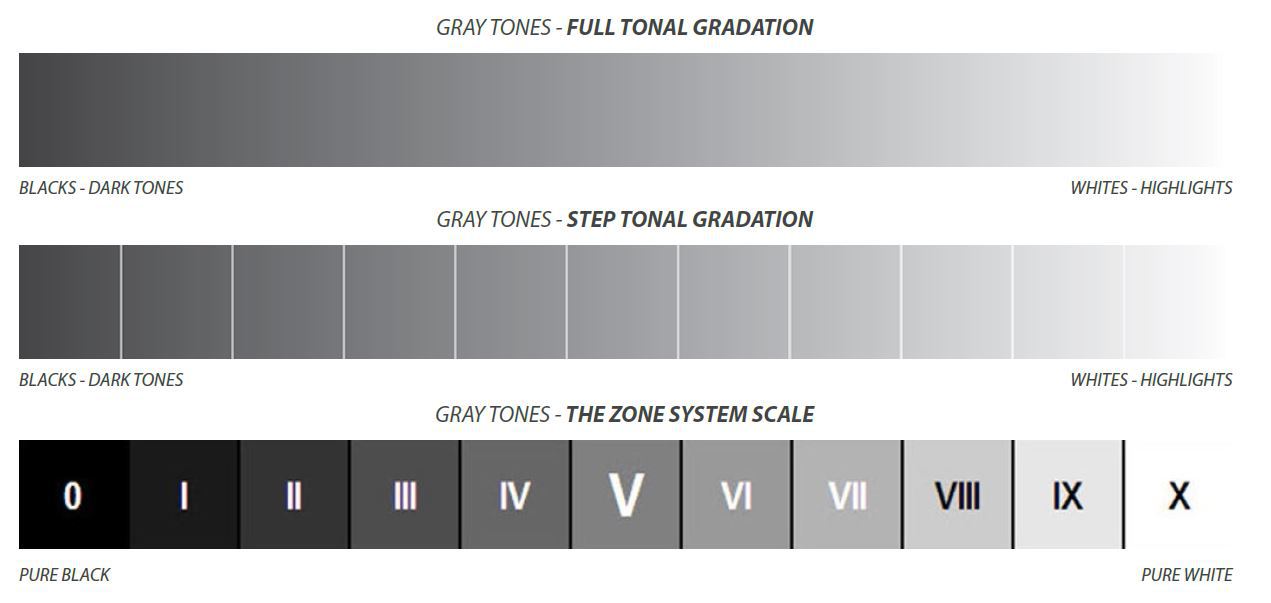
Now that we saw how powerful the contrast can be, to draw the attention of the on-lookers let's go even further in our mission to seduce the viewer and see what is the next most important thing, once we have created the right contrast and we have the viewer's attention. Next, you should fill the gaps between black and white and this is one of the most important principles of black and white photography.
Your goal when processing an image in black and white is to cover the entire tonal range between black and white , by representing in the image all the in-between gray tones: the mid-grays, as they are also called.
You need to create images that have the right amount of contrast but also cover the entire tonal range. Contrast is used to draw the attention of the viewer to the image and to the main subject, but the mid-grays are what will retain the eye of the viewer in the image and make them willing to explore the image more. Which shows how important the mid-grays are. You don't need to have the same amount of each gray tone, but you need to cover all of them in your image.
You can think about the pure white and pure black tones as the cherry on the cake, while the mid-grays ARE the cake.
9/ THE RELATION BETWEEN CONTRAST AND MID-GRAYS IN BLACK AND WHITE PHOTOGRAPHY

The relation between contrast and mid-gray tones is another topic that couldn't be missing from a complete guide to black and white fine art photography and that any serious black and white photographer should have in mind when creating. Let me tell you here a bit more about the mid-grays and their relation to contrast, since I've seen that many photographers have difficulty in striking a balance between these two, and this is why this is one of the topics I insist on when I work with my workshop and mentoring students.
Something I have seen frequently being used as a tool to make the image pop, is the tendency to boost the contrast more than it is necessary. The problem when you do this is that the result will be only an image that pops, not an image that keeps you there exploring its secrets. Very dark tones, as well as very bright ones, attract the eye because they are strong, and this is why you need to have them and also some touches of pure white and pure black, because they are the ones that draw your attention, but it is the mid-gray tones that will tell the story and that, for me, will make a black and white photograph make you say wow. They are the element that will give you the dreamy look in a black and white fine art photograph and make you want to know more about the story.
I find the mid-grays, especially the dark mid-grays something that is on one hand very difficult to control well, and on the other hand something that can be extremely emotional and powerful and will play an important role in how you will feel about an image.
The contrast attracts you into the image, but the mid-grays will seduce and keep you there fascinated, exploring the story. If you see it like this you will know where you need to use contrast and where to use mid-grays.
Because I believe that you can understand best if you see it, here are some examples of great images using mid-grays and dark mid-grays that I collected on Pinterest, so you see what I mean. Look at the beauty of these tones, they are almost touching you physically. I'm sharing with you 3 of my Pinterest galleries with the best work by Ansel Adams, Edward Weston and Clyde Butcher, 3 masters of black and white photography and of the mid-gray tones.
Ansel Adams
I'm sure you know a lot about Ansel, the undeniable "father: of black and white fine art photography. Here is even more about Ansel Adams' work on Artsy.
Edward Weston
Another "father" of black and white fine art photography, here is more about Edward Weston's work on Artsy. I have a special sweet spot for his nude studies.
Clyde Butcher
Also more about Clyde Butcher on his website. Clyde is closer in time to our generation, but his work with gray tones is outstanding and his passion for photography is admirable.
And here is where you can find a collection of breath-taking images that use mid-grays in the best way. It is a sublime pleasure to look at these images. There are some of my images too in this collection and yes, I love to look at these images.
Gray Tones in Black and White Photography
Something to look for and keep in mind.
Do no forget the gray tones even when you choose to work with very contrasty images or with low-key or high-key images. They will always tell the story more eloquently.
You can see in my image Ode to Black | Black Hope V – Persona Black below what I mean, that you need gray tones even if you work with very contrasty and dark images, as I was doing in my series Ode to Black, a series I created during 2012-2013, where I aimed to go as far with reducing light until I touch the limits where photography is not possible anymore.
Even if the gray tones lying in between black and white are there in a very small amount, as in a low-key or a high-key image, you still need to cover the entire tonal range in your image in order to make the image believable and realistic from the point of view of the light you create in it, and not only a graphical representation, as it would become if you only used high contrast but not enough filling with gray tones.

10/ HOW TO SHOOT BLACK AND WHITE PHOTOGRAPHY TO COVER THE ENTIRE TONAL RANGE
When you shoot with the intention of creating a black and white photograph. try to shoot images that will already cover the entire range of gray tones, even before converting the image to B&W, meaning shooting photographs that cover many gradations of light. The best moment to capture an image that will cover a large tonal distribution is when the scene you are shooting is not too contrasty. You can accomplish that by shooting on a rather cloudy or a semi-cloudy day, when the sun is filtrated through the clouds. Bright sunlight can make your image seem too contrasty and may create intense shadows, which can have as a result losing the softness and delicacy the mid-gray tones bring.
11/ HOW TO EDIT BLACK AND WHITE PHOTOGRAPHY TO COVER THE ENTIRE TONAL RANGE

n the phase of post-processing, keep in mind that a very important thing is to use the light you have to your advantage, either by using it as you capture it or by modifying it in post-processing to suit your goals. The way you modify the light in the image is by using smartly the gradations between black and white – the gray tones.
You have to always think about where to use a certain gray tone and why – why use that specific tone and not another, why you need that specific intensity, what you want to achieve by placing it in that area and not somewhere else.
Remember that white and bright tones reveal – they help the eye concentrate on the area where they appear, drawing the attention to them, and black and dark tones conceal – they make the areas where they appear seem less noticeable, thus less important in the hierarchy of the image. Use them both wisely so you can guide the eye of the viewer towards the areas of the image you consider more important and subdue the areas you don't need to highlight in your story or that are distracting in your image (too cluttered, too intense, not related to the subject etc.)
Except for reading this guide to black and white fine art photography, you can also watch below a video tutorial I created about black and white fine art post-processing with Photography Drawing and generally about how to create a black and white fine art photograph – everything about the vision, composition and post-processing part of the act of creation in black and white.
Also, you can read the eBook 'Advanced Black and White Processing that comes as a bundle with my video tutorial Long Exposure, Architecture, Fine Art Photography – Creating (en)Visionography where I demonstrate my entire workflow for processing black and white fine art photography and long exposure photography.
12/ HOW TO USE YOUR SOFTWARE TO CREATE BLACK AND WHITE PHOTOGRAPHY
The more control you have over your image when working in black and white, the better. This means you will rely on your software to create your images even more than you will rely on your camera to capture them. You have to be aware of the power of this tool: your editing software. Do not be afraid to use it at its full potential.
Controlling the way you process an image is what will help you create fine art photography, in opposition to traditional photography (documentary etc.). The more control you have over the image, the better. You need to have control over the way you play with light and shadow, the way you deal with the balance between them, and over creating the right intensities of light as well as of shadow, in order to sustain and emphasize your composition, and to reveal your subject through enhancing the light on it. The more control you have over these elements, the closer you will be to recreating your vision about the subject you chose in the black and white image you produce, the closer you will be to telling your story in a way that will move the viewer.
Use your software not only to convert an image to black and white but to create a black and white photograph.
The image you start with may have nothing to do with the image you deliver as a final piece of work. The difference between them has to do with your vision and using the editing software to recreate your vision in the photograph you make.
The intention of this guide to black and white fine art photography is not necessarily to get into details about post-processing, I am doing that extensively in my workshops and black and white photography courses. However, following I will present to you the most important tools and ideas related to my black and white post-processing so you can start applying these ideas right away.
13/ WHAT SOFTWARE TO USE IN BLACK AND WHITE FINE ART PHOTOGRAPHY

The software that will give you the most control over your images is Photoshop. This is the king in fine art photography because it is such a rich software that will allow you to edit in-depth your image. If you combine Photoshop with Lightroom and a few more pieces of software that can be used as plugins inside Photoshop or Lightroom, you will have even more control over your images.
Except for Photoshop and Lightroom., I am also using some additional plugins that work both n Photoshop and Lightroom, as well as stand-alone programs. These plugins are Topaz Labs, Luminar, DxO and NIK Software.
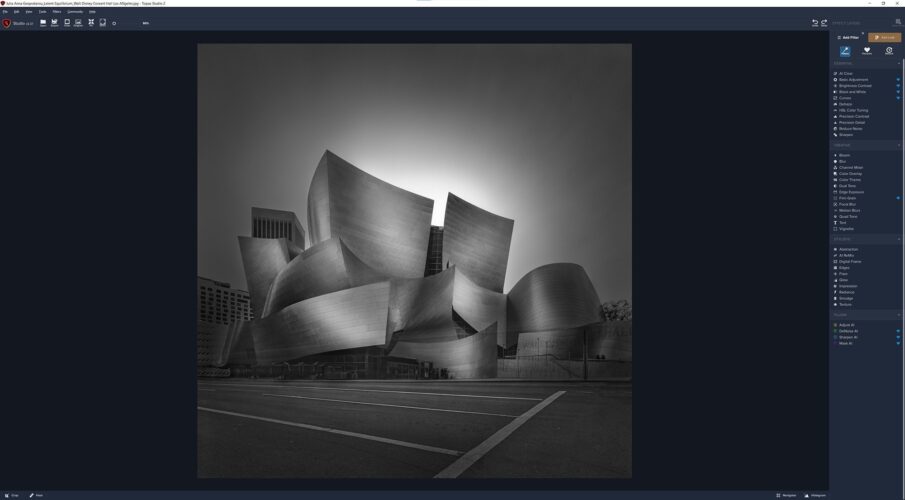
The plugins I use and recommend for working in black and white photography are mainly the Topaz plugins: Topaz Studio with the integrated sub-plugin/filter for B&W conversion in Studio, and the new Topaz AI Bundle: Topaz Sharpen AI (sharpening, enhancing details), Topaz DeNoise AI (denoising), Topaz Mask AI (creating complex selections and masks), Topaz Gigapixel AI. Topaz has done a lot these past years to develop some fantastic pieces of software and the new AI plugins they created are simply exceptional, which is why I'm using them in each and every image I make. If you decide to work with the Topaz plugins or if you already work with them and want to expand your collection, you can use my discount code JULIAG to get 15% discount on any order made from the links above.
Another plugin I am using in some cases is Luminar. Luminar has improved very much lately and the new Luminar AI version promises to become a really good tool for fine art photography. Just like with Topaz, you can use my discount code JULIAG to get 10% discount on any order for Luminar made from the link above.
Except for Topaz and Luminar, DxO is another software I am using with DxO ViewPoint (perspective control) DxO FilmPack (black and white conversion, which has many classic film photography effects), and DxO PhotoLab (sharpening, denoising, detail and clarity enhancing, RAW file enhancing). DxO PhotoLab can be used as a stand-alone application or as a plugin in Lightroom. Sometimes I also use NIK Silver Efex Pro (black and white conversion) but less frequently and especially for its Control Points feature. After having been acquired by Google some years ago, without getting any improvement after that, NIK is now owned by DxO. They made some changes to improve the plugin but they could do more so I'm hoping it will be updated and upgraded further.
14/ MY TYPICAL BLACK AND WHITE FINE ART PROCESSING WORKFLOW WITH MY METHOD PHOTOGRAPHY DRAWING™ (PhtD)
1/ My processing workflow starts in Lightroom and DxO PhotoLab where I make the first corrections and apply the first enhancements to the RAW file – exposure, general contrast, clarity, dust spots cleaning etc.
2/ Export the image as PSD 16bit file to Photoshop where I crop the image and continue with applying further enhancements to the color image.
.3/ Correct the perspective by using DxO ViewPoint, especially when working on architectural photographs then decide the framing and cropping.
4/ Denoise and sharpen the color photograph by using Topaz DeNoise AI and Topaz Sharpen AI.
5/ Create the main selections by using selection tools in Photoshop together with Topaz Mask AI for more complex selections. In the case I need to create complex selections or when working with landscape images, I also use Luminosity Masks, Channel-based selections, Color hue based selections etc.
6/ Convert the color image to black and white using most of the times the B&W conversion filter (sub-plugin) in Topaz Studio, or sometimes DxO FilmPack depending on the look I'm after.
7/ Work on sculpting the light by using my processing method Photography Drawing (see From Basics to Fine Art book and my courses for details). In this phase, I work mainly in Photoshop by using layers (simple layers or adjustment layers), blending modes, gradients, dodge and burn. The way I work on my images is by using selections to apply the effects I want to create in the image. This is something you can only do in Photoshop, or manly in Photoshop, even if other programs like Lightroom, or Topaz Studio can do it too to a certain degree. But the subtlety of light that I am after can only be achieved if I use Photoshop as the most refined processing tool to create the end result.
8/ Use the plugins I mentioned above in Photoshop or as stand-alone applications, as additional tools in different phases of my post-processing, when the effects I can create with them are easier to obtain than by creating them in Photoshop.
15/ CONCLUSION TO THE GUIDE TO BLACK AND WHITE FINE ART PHOTOGRAPHY
After going through all these aspects of creating black and white photography, my advice for the photographer who wants to create this type of photography is to try to keep in mind all these principles and practical aspects of conceiving, shooting, and processing black and white photography and apply them in creating your own images, not only when working with certain subjects but generally throughout your fine art photography work.
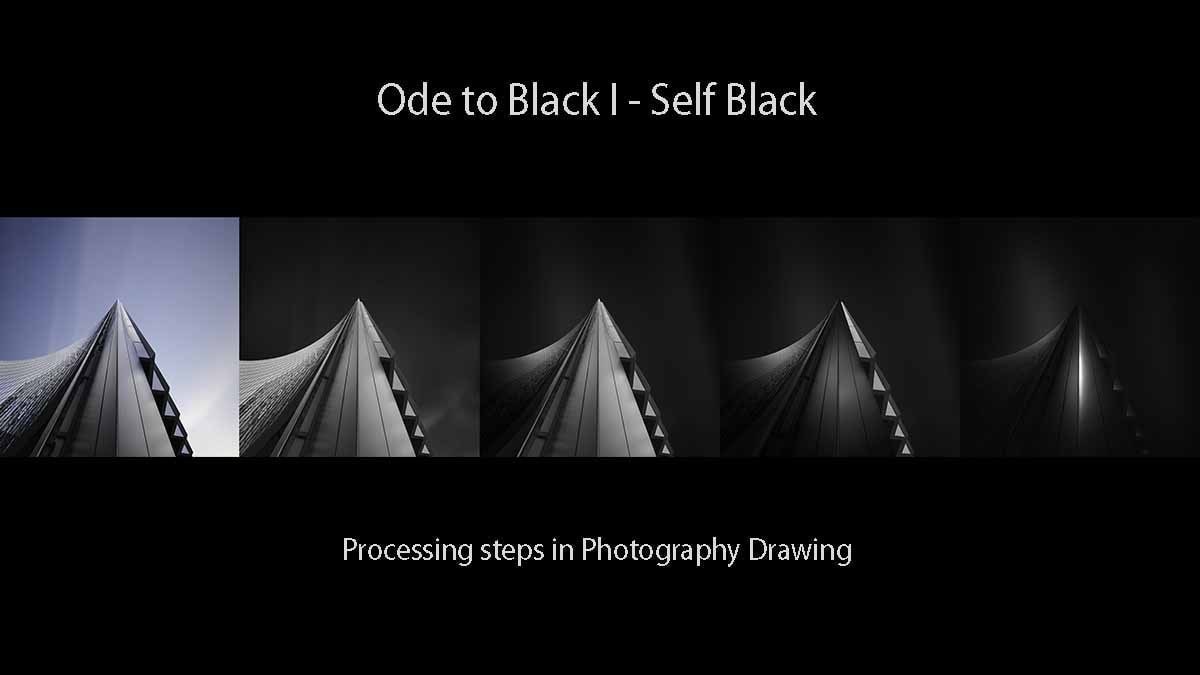
It may be difficult in the beginning to see the world through a black and white prism and to process your photographs in a specific monochrome way but in time and if you are persistent and work on mastering the techniques for creating black and white photography, it will become second nature and it will help you express your vision in black and white in a much more accurate and impressive way. Then you will be able to move the viewer and trigger emotion in their heart in the same way you were moved when you created your images.
Remember that the goal of black and white photography is to create and transmit emotion and to inspire the viewer to feel the same excitement you felt when creating your art.
I hope you enjoyed this guide to black and white fine art photography and that it will give you inspiration and practical tools to create outstanding black and white fine art photography.
If you want to take your craft to the next level, I hope to see you soon in one of my workshops or mentoring programs.
You can find more resources about fine art black and white photography, (en)Visionography, long exposure photography and architecture photography in my extensive collection of photography tutorials. To receive my future tutorials directly via email you can subscribe to my website.
Source: https://www.juliaannagospodarou.com/complete-guide-black-and-white-fine-art-photography/
0 Response to "Black and White Photography Black and White Easy Drawings"
Post a Comment